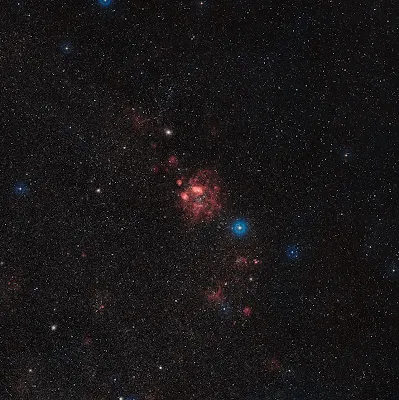H
λωρίδα αερίων που διαπερνά τον γαλαξία
μας πηγάζει από δύο γειτονικούς μας
γαλαξίες. These images show wide and close-up views of a
long ribbon of gas called the Magellanic Stream, which stretches
nearly halfway around the Milky Way. In the combined radio and
visible-light image at the top, the gaseous stream is shown in pink.
The radio observations from the Leiden/Argentine/Bonn (LAB) Survey
have been combined with the Mellinger All-Sky Panorama in visible
light. The Milky Way is the light blue band in the centre of the
image. The brown clumps are interstellar dust clouds in our galaxy.
The Magellanic Clouds, satellite galaxies of the Milky Way, are the
white regions at the bottom right. The image at the bottom, taken at
radio wavelengths, is a close-up map of the Magellanic Stream that
also was generated from the LAB Survey. Researchers determined the
chemistry of the gas filament by using Hubble's Cosmic Origins
Spectrograph (COS) to measure the amount of heavy elements, such as
oxygen and sulphur, at six locations (marked with an "x")
along the Magellanic Stream. COS observed light from faraway quasars
that passed through the stream, and detected the spectral
fingerprints of these elements from the way they absorb ultraviolet
light. Quasars are the brilliant cores of active galaxies. These
observations show that most of the gas was stripped from the Small
Magellanic Cloud about two billion years ago — but surprisingly, a
second region of the stream was formed more recently from the Large
Magellanic Cloud. The pink circles to the right mark the location of
the Small and Large Magellanic Clouds. Credit:
Credit
for the radio/visible light image: David L. Nidever, et al.,
NRAO/AUI/NSF and Mellinger, LAB Survey, Parkes Observatory,
Westerbork Observatory, and Arecibo Observatory. Credit for the radio
image: LAB Survey
Στα
μέσα της δεκαετίας του 1960 οι επιστήμονες
διαπίστωσαν ότι μια γιγάντια κοσμική
λωρίδα διαπερνά σχεδόν τον μισό γαλαξία
μας. Η λωρίδα αποτελείται από αέρια και
οι επιστήμονες προσπαθούσαν όλα αυτά
τα χρόνια να εντοπίσουν την πηγή της.
This
wide field view of part of the Large Magellanic Cloud includes the
location of the N11 star formation region. This image was created
from digitised photographs through red and blue filters. The field of
view is about three degrees across. Credit:
ESO/Digitized
Sky Survey 2. Acknowledgment: Davide De Martin
Τα
στοιχεία που είχαν στη διάθεση τους οι
ειδικοί έδειχναν ότι η λωρίδα αυτή
σχετίζεται άμεσα με δύο μικρότερους
γειτονικούς μας γαλαξίες, το Μεγάλο και
το Μικρό Νέφος του Μαγγελάνου. Για αυτό
και οι επιστήμονες την ονόμασαν «Το
Ρεύμα του Μαγγελάνου».
The
two-colour image shows an overview of the full Small Magellanic Cloud
(SMC) and was composed from two images from the Digitized
Sky Survey 2.
The field of view is slightly larger than 3.5›. Credit:
ESA/Hubble
and
Digitized
Sky Survey 2.
Acknowledgements: Davide De Martin
Ομάδα
ειδικών με επικεφαλής επιστήμονες του
Space Telescope Science Institute στη Βαλτιμόρη
ανέλυσε πρόσφατες παρατηρήσεις του
διαστημικού τηλεσκοπίου Hubble και επίγειων
τηλεσκοπίων. Οι ερευνητές εντόπισαν
νέα ενδιαφέροντα στοιχεία για αυτή τη
μυστηριώδη κοσμική δομή. H λωρίδα των
αερίων φαίνεται ότι δημιουργήθηκε πριν
από περίπου δύο δισεκατομμύρια έτη στο
Μικρό Νέφος του Μαγγελάνου. Όπως όμως
προκύπτει από τις νέες παρατηρήσεις
κάποια στιγμή σε πιο πρόσφατους χρόνους
το ρεύμα των αερίων που κινούνται με
μεγάλες ταχύτητες άρχισε να τροφοδοτείται
και από το Μεγάλο Νέφος του Μαγγελάνου
γεγονός που εξέπληξε τους επιστήμονες
αφού το ρεύμα φαίνεται να έχει τώρα δύο
πηγές. Η μελέτη του ρεύματος συνεχίζεται
ώστε να αποκαλυφθούν και άλλα δεδομένα
για αυτό.













